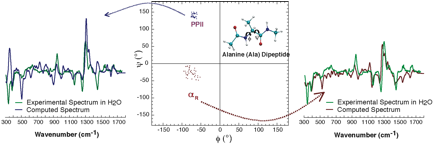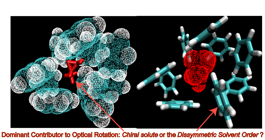Last updated: Wednesday 13-Jan-2010 2:37 PM
 |
Parag Mukhopadhyay, Postdoctoral Fellow Laboratory of Molecular Biology and Biochemistry Detlev W. Bronk Building, 502 The Rockefeller University, Box 187 Telephone: 212-327-8283 |
 Figure 1. Measured (green) and computed Raman optical activity spectra derived from the extended left-handed PPII (blue) and the compact right-handed aR (red) helical conformations of an alanine dipeptide model in aqueous solution. The fact that the simulated spectra account for the key experimental spectral features indicates that the dipeptide model assumes these conformations in aqueous solution (Mukhopadhyay et al. Biophys. J. 2008,95:5574-5586). |
Education:
|
 Figure 2. Optical rotatory dispersion of (S)-methyloxirane in benzene is dominated by the dissymmetric benzene cluster surrounding the chiral solute (Mukhopadhyay et al. Angew. Chem. Int. Ed., 2007, 46:6450-6452). This work was also highlighted in Angew. Chem. Int. Ed. 2007, 46:7738-7740.
Figure 2. Optical rotatory dispersion of (S)-methyloxirane in benzene is dominated by the dissymmetric benzene cluster surrounding the chiral solute (Mukhopadhyay et al. Angew. Chem. Int. Ed., 2007, 46:6450-6452). This work was also highlighted in Angew. Chem. Int. Ed. 2007, 46:7738-7740. |
|
Research: Summary: Modern chemistry emerged from the quest to describe the three-dimensional (3D) structure of molecules: van’t Hoff’s tetravalent carbon placed symmetry and dissymmetry at the heart of chemistry. We used modern chiroptical theory to elucidate the symmetry and dissymmetry of molecules and their assemblies. Chiroptical spectroscopy, including optical rotatory dispersion, electronic circular dichroism, vibrational circular dichroism, and Raman optical activity, measures the response of dissymmetric structures to electromagnetic radiation. This response can in turn reveal the arrangement of atoms in space, but deciphering the molecular information encoded in chiroptical spectra requires an effective theoretical approach. The computation of chiroptical signatures, in close coordination with synthesis and spectroscopy, provides a powerful framework to diagnose and to interpret the dissymmetry of chemical structures and molecular assemblies. We used chiroptical theory to elucidate 3D structures of molecules in solution (Figure 1), and explain how dissymmetry is templated and propagated in the condensed phase (Figure 2). |
||
|
||
| Published Papers: |
||
7). |
||
6). |
||
| 5). P. Mukhopadhyay, G. Zuber, P. Wipf, D.N. Beratan Contribution of a solute’s chiral solvent imprint to optical rotation. Angewandte Chemie International Edition, 2007, 46:6450-6452. PMID: 17645276 [PubMed] |
||
| 4). P. Mukhopadhyay, G. Zuber, M. R. Goldsmith, P. Wipf, D.N. Beratan Solvent effects on optical rotation: A case study of methyloxirane in water. ChemPhysChem. 2006, 7:2483-2486. PMID: 17072929 [PubMed - indexed for MEDLINE] |
||
| 3). P. Mukhopadhyay, L. Monticelli, D.P. Tieleman. Molecular dynamics simulation of a palmitoyloleoyl-phosphatidylserine bilayer with Na+ counterions and NaCl Journal Citation: Biophysical Journal, 2004, 86:1601-1609. PMID: 14990486 [PubMed - indexed for MEDLINE] |
||
| 2). P. Mukhopadhyay, H. J. Vogel, D.P. Tieleman. Distribution of pentachlorophenol in phospholipid bilayers: A molecular dynamics study Biophysical Journal, 2004, 86:337-345. PMID: 14695275 [PubMed - indexed for MEDLINE] |
||
1). |
||
|
||
| Posters: |
||
| 4). P. Mukhopadhyay, Zuber, G., Wipf, P., and Beratan, D. N., “Modeling chiroptical properties of molecules in solution”, 233rd National American Chemical Society Meeting, Chicago, March 2007. |
||
| 3). P. Mukhopadhyay, Zuber, G., Goldsmith M. R., and Beratan, D. N., “Modeling solvent effects on optical rotation of chiral molecules”, Symposium on Photonics at the Frontiers of Science and Technology, Fitzpatrick Center, Duke University, September 2006. |
||
| 2). P. Mukhopadhyay, Vogel, H. J., and Tieleman, D. P., “Distribution of pentachlorophenol between water and phospholipids bilayes: A molecular dynamics study”, Biophysical Society Annual Meeting, San Antonio, February 2003. |
||
| 1). P. Mukhopadhyay and Tieleman, D. P., “Molecular dynamics simulation of negatively charged phospholipids bilayer”, Canadian Society for Biochemistry, Molecular, and Cellular Biology Annual Meeting and International Symposium on Membrane Proteins in Health and Disease, Banff, March 2002. |